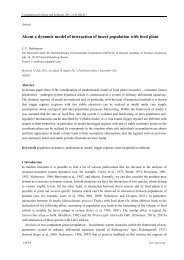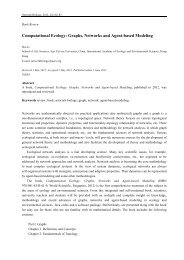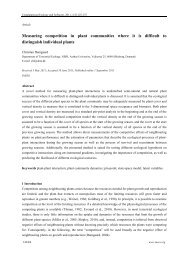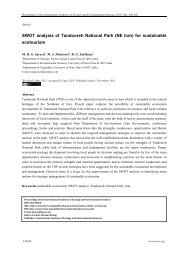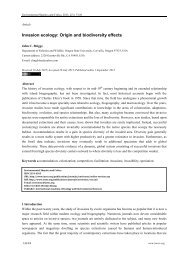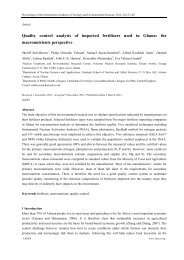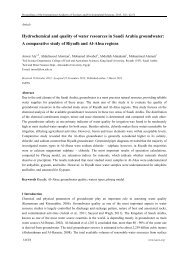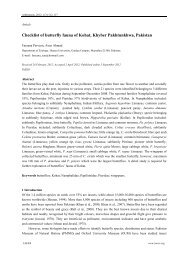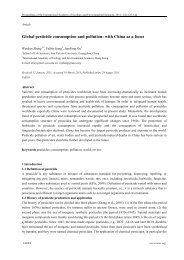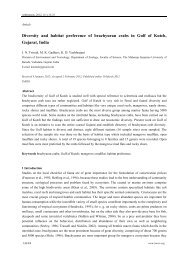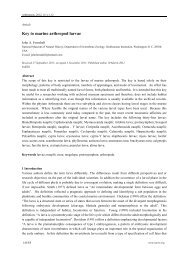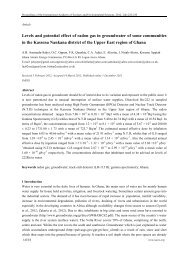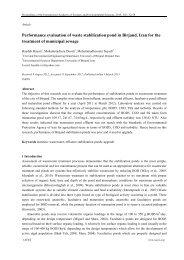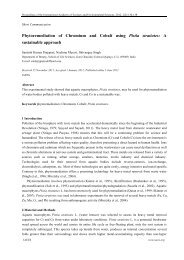Threatened medicinal plants of Menwarsar Pahalgam, Kashmir ...
Threatened medicinal plants of Menwarsar Pahalgam, Kashmir ...
Threatened medicinal plants of Menwarsar Pahalgam, Kashmir ...
Create successful ePaper yourself
Turn your PDF publications into a flip-book with our unique Google optimized e-Paper software.
30<br />
Proceedings <strong>of</strong> the International Academy <strong>of</strong> Ecology and Environmental Sciences, 2013, 3(1): 25-35<br />
Table 4 Categorization <strong>of</strong> the assessed taxa in to different groups.<br />
Consumption<br />
Species name Rate in<br />
Rupees<br />
Mostly<br />
Household<br />
Mostly<br />
commercial<br />
Both Trade value<br />
(existing)<br />
Nature<br />
trade<br />
<strong>of</strong><br />
P. hexandrum 300 - 650 + _ _ Lowest Illegal<br />
P. kurroa 400 -800 + _ _ Low Illegal<br />
A.heterophyllum 4500 _ + _ High Illegal<br />
R. emodi 300 - 500 + _ _ Low Illegal<br />
A.benthamii 1200 - 1800 _ _ + High Illegal<br />
M. aculeata 800 - 1000 + _ + Low Illegal<br />
Note: Denotes the price which people get / kg from the middlemen and thus not reflect the market price.<br />
Table 5 Comparative account <strong>of</strong> population status (density/m 2 ) <strong>of</strong> selected<br />
plant species at selected localities <strong>of</strong> <strong>Pahalgam</strong>.<br />
Name <strong>of</strong> species <strong>Menwarsar</strong> Chhumnai Liderwart<br />
P. hexandrum 1.73 1.96 1.30<br />
P. kurroa 1.2 0.96 0.97<br />
A. heterophyllum 0.56 0.4 0.35<br />
R. emodi 0.36 0.46 0.58<br />
A. benthamii 0.16 0.13 _<br />
M. aculeata 0.13 0.1 _<br />
Note: (-) absent<br />
Almost all these plant species are used to cure common ailments like cough, cold, headache, asthma, fever,<br />
bronchitis and stomach pain by all the three ethnic tribes (Table 1). Furthermore species like A. heterophyllum<br />
are also used for some specific cases. A comparison <strong>of</strong> species indicates that A. heterophyllum and P. kurroa<br />
are the Prioritized <strong>medicinal</strong> <strong>plants</strong> for these people in terms <strong>of</strong> their ethno <strong>medicinal</strong> properties and uses.<br />
These <strong>plants</strong> have known antibacterial, anti- inflammatory and antipyretic properties, which together with their<br />
high market value make them a species <strong>of</strong> choice among all the three communities. These <strong>plants</strong> are also used<br />
frequently for their ethno veterinary applications by these tribes. Notable in this regard is R. emodi and P.<br />
kurroa which are used by the communities to cure different diseases <strong>of</strong> their livestock. Specifically the R.<br />
emodi is used to cure cough, dysentery, eye diseases, skin problems, constipation, ho<strong>of</strong> diseases, internal injury<br />
and broken horn <strong>of</strong> livestock by these communities while P. kurroa is used mostly to cure elementary<br />
disorders, in digestion, tonsils and intestinal worms by Bakerwals and Gujjars. Similarly P. hexandrum are<br />
specifically used for cuts, wounds and bone fracture.<br />
IAEES<br />
www.iaees.org



